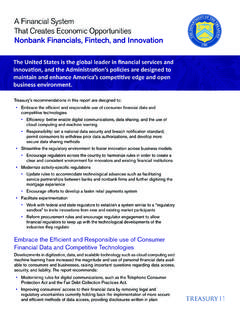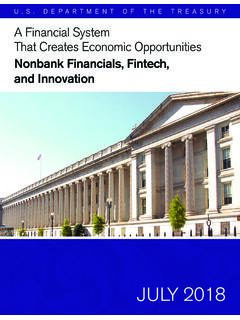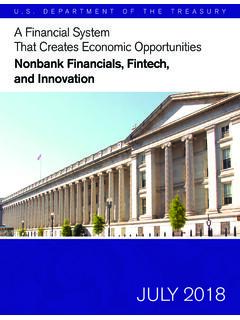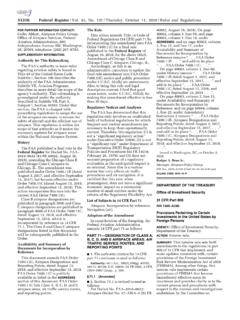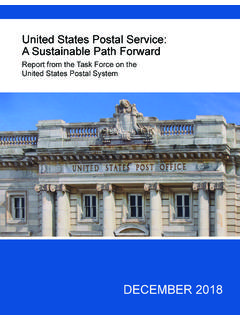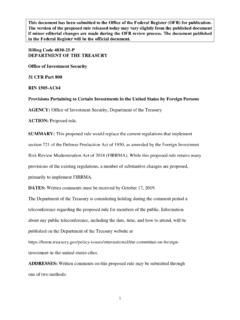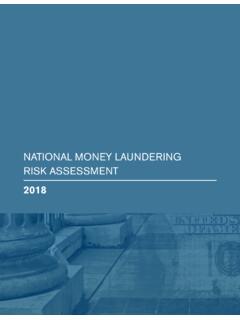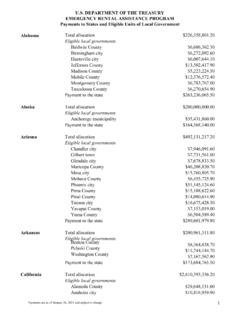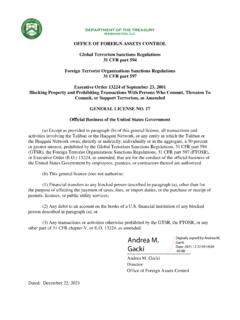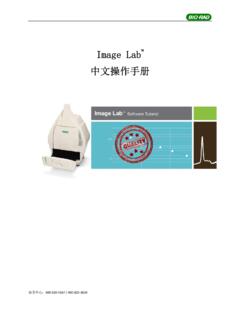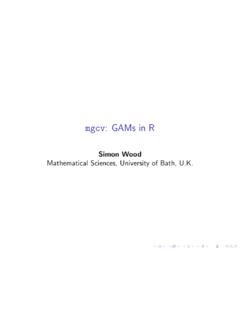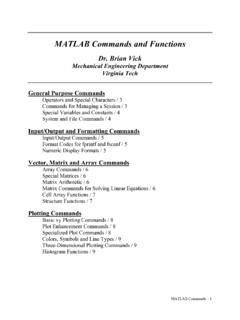Transcription of The Treasury Breakeven Inflation Curve
1 THE Treasury Breakeven . Inflation Curve . James A. Girola Department of the Treasury March 26, 2019. 1. Introduction This presentation describes the Treasury Breakeven Inflation (TBI) Curve , which provides Breakeven Inflation rates derived from nominal Treasury notes and bonds and TIPS. Breakeven Inflation rates are future Inflation rates embedded in the Treasury securities market. Breakeven rates pertain to Inflation of the (not seasonally adjusted) Consumer Price Index for All Urban Consumers (CPI-U). The Treasury TBI Curve uses methodology that overcomes deficiencies in other approaches. 2. Introduction Although TBI rates can be influenced by a variety of short-term factors, on balance over time they are reliable indicators of market expectations for future Inflation .
2 Therefore, they can be used to compute projections of Inflation into the future which are in accord with markets. Inflation projections have many uses, including economic forecasting, pension trust funds, and conversion of future nominal cash flows to real payments, as in the Blended Retirement System. Moreover, when combined with projected real interest rates based on the structure of the economy, projected Inflation can forecast future nominal interest rates. 3. Treasury Yield Curves The TBI Curve is one of a set of yield curves done by Treasury . Data generated by these curves are already used by the Defense Department. The first Treasury Curve is the Treasury Nominal Coupon-Issue (TNC) Yield Curve , which pertains to Treasury nominal coupon issues. The second is the Treasury Real Coupon-Issue (TRC) Yield Curve for Treasury Inflation -Protected Securities (also known as TIPS).
3 And the third is the High Quality Market (HQM) Corporate Bond Yield Curve , which pertains to high quality corporate bonds. The following discussion summarizes these curves and their methodology. The last slide contains links for more information. 4. The HQM Yield Curve The HQM corporate bond yield Curve is produced as mandated by the Pension Protection Act of 2006 (PPA). This Curve pertains to high quality corporate bonds, that is, bonds in the top three qualities AAA, AA, and A. To meet the requirements of the PPA, it was necessary to invent a new yield Curve methodology at Treasury for the HQM Curve . The methodology is sketched out below. The HQM Curve data are disseminated by IRS and by the Treasury Office of Economic Policy, and include spot rates and related yields that are used by single-employer pension plans to discount future liabilities.
4 HQM yield Curve data are available back through 1984. The HQM yield Curve is also used in the Blended Retirement System. 5. The TNC Yield Curve The HQM methodology was subsequently applied to the Treasury market to produce the TNC yield Curve , which pertains to Treasury nominal coupon issues, both notes and bonds. The TNC Curve includes both on-the-run issues (securities most recently issued of each maturity) and older off-the-run issues. However, in this presentation the focus is on spot rates from off- the-run issues. The initial application of the TNC yield Curve was to discount future liabilities of various federal agencies including the Defense Department, such as pension and other postemployment liabilities, for the agencies' audited financial statements and for the annual Financial Report of the Government.
5 The TNC Curve goes back through 1976, and is the most extensive Treasury yield Curve dataset currently available. 6. The TRC Yield Curve The HQM and TNC methodology was subsequently used to produce the TRC yield Curve . The TRC yield Curve is the real yield Curve derived from Treasury Inflation -Protected Securities or TIPS, and includes both real notes and real bonds. And the nominal TNC and real TRC yield curves are combined to derive the Treasury Breakeven Inflation (TBI) Curve . The TRC yield Curve and the TBI Curve are both available back through 2003. 7. Yield Curve Data These yield curves each provide several sets of data, including spot rates, selected par yields, and forward rates. The TNC Curve provides off-the-run and on-the-run data. The curves are calculated late in the day on each business day, and the results are disseminated each month.
6 The spot rate data, which are of particular interest for Breakeven Inflation , include monthly averages of daily spot rates, as well as end of month spot rates from the TNC and TRC curves and the TBI Curve as a combination of these. 8. Yield Curve Data, continued Spot rates are available for each maturity at half-year intervals starting at year up through 100 years, for a total of 200 maturities. Rates beyond 30 years maturity are projected as described below. All spot rates are semiannually compounded, except, following convention, TBI rates are annually compounded. 9. Yield Curves for January 2019. Slide 12 contains the average TNC, TRC, and HQM spot yield curves for January plus the TBI Breakeven Curve . All curves are projected out through100 years maturity.
7 The HQM spot rate is percent at 30 years maturity, compared to percent and percent for the TNC and TRC. spot rates, respectively. The TBI rate is percent at 30 years maturity. The HQM rate exceeds the TNC rate largely because of corporate bond default risk, and the TNC rate exceeds the TRC rate with positive Inflation . 10. Yield Curves for January 2019, continued The spot yield curves rise gradually throughout the projection range from 30 years maturity through 100 years maturity, which is typical. At 100 years maturity, the HQM spot rate is percent, the TNC rate is percent, the TRC rate is percent, and the TBI rate is percent. 11. SPOT YIELD CURVES. January 2019, Percent 5 5.. 4 . HQM 4. TNC.. 3 3. TBI. 2..- - - - -- - - - - - 2. 1 1. TRC. Maturity 0 0. 10 20 30 40 50 60 70 80 90 100.
8 12. Methodology Features The methodology used for the yield curves contains features and capabilities that do not appear in other yield Curve approaches: The methodology makes use of established bond market characteristics to generate a stable yield Curve that captures market movements. The methodology projects yields beyond 30 years. The methodology combines regression variables with the yield Curve . 13. Methodology Features, continued The requirements of the PPA made necessary the invention of this methodology, which is new and more extensive. In particular, this methodology is grounded in established bond market characteristics, which generate and justify the mathematical form of the yield Curve . The following slides summarize details of this methodology. 14.
9 Maturity Ranges A central feature of the methodology is that it breaks the yield Curve into maturity ranges. This is because trading in securities tends to divide into maturity ranges, such that the trading activity in each range on average reflects similar purposes, similar views of risk, and similar expectations about securities in that range. Because market views can be considered similar for securities in the same range, yields in each maturity range are related to each other in a simple fashion. Consequently, this methodology models yields, and in particular forward rates, in each maturity range as a smooth ( cubic ). function, and joins the functions together smoothly across ranges (as a cubic spline ). 15. Maturity Ranges, continued At the present time five maturity ranges are used for the yield curves, delineated by the maturity points 0, , 3, 7, 15, and 30.
10 Years maturity. These points provide separate ranges for the critical maturities of 2 years, 5 years, the benchmark 10 years, and 30 years. The choice of fixed maturity ranges increases significantly the stability of the yield Curve estimates over time. In addition, the methodology is statistically straightforward to estimate, generating statistical equations that are well conditioned. 16. The Long-Term Forward Rate The methodology must also be able to project yields and Inflation rates beyond 30 years maturity out through 100 years. First of all, the long-term forward rate at and beyond 30 years maturity is set to a constant, because there are not enough data to estimate accurately movements in the forward rate beyond 30. years maturity. Then this constant is taken to be the average forward rate in the 15- to 30-year maturity range.
